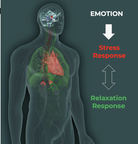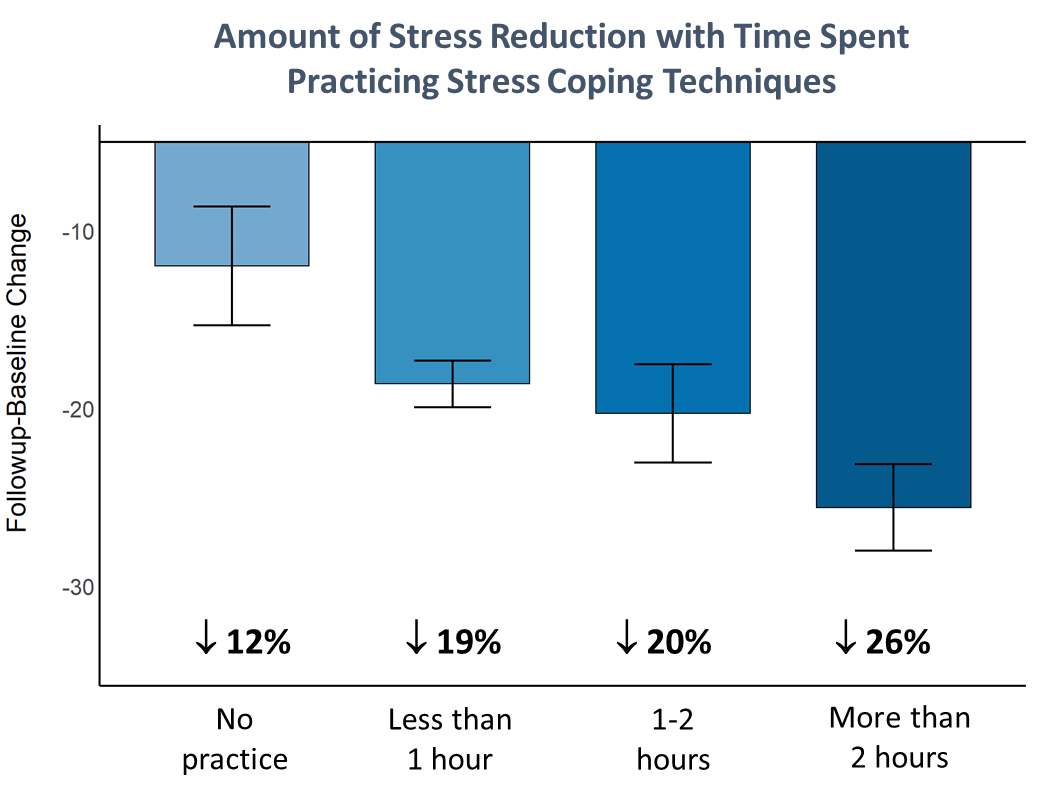*This is an article from the Winter 2021 2022 issue of Contentment Magazine.
By Evian Gordon, MD, PhD, FAIS, Founder and Chief Medical Officer, Total Brain and Donna Palmer, PhD, Chief Scientific Officer, Total Brain
In this article we will share with you a brain-based view of stress and the data collected regarding the effects of COVID in triggering stress in employees in large corporations across the US. We will suggest 5 ways for you to consider reframing your stress and activating your relaxation response in this phase of the COVID era, as you resolve going back to work decisions and begin to embrace the holidays.
A Brain-Based View of Stress
At its core, your brain is wired to identify cues to avoid threats to keep you safe and identify possible rewards. This ongoing process is unconscious and occurs within a fifth of a second. It is the basis of your emotions, intuition and negative/positive biases that shape many of the approximately 50,000 thoughts you have every day.
Not only can cues trigger stress, but just thinking about physical or social threat cues can trigger stress. These unconscious processes are modulated by slower more detailed conscious rational cognition, including memory, focus and planning that can override these unconscious emotion-stress triggers. From the brain’s point of view, stress occurs when your negative unconscious thoughts are greater than your capacity to consciously cope with them effectively.
Some stress is helpful, such as getting you out of immediate danger or to help you focus to complete a task. But when any perceived threat is intense it induces a Stress Response that includes activation of your fight or flight reflex. When stress is overwhelmingly negative or continually triggered and becomes chronic, it derails performance and increases the likelihood of mental disorder and chronic disease.
On the opposite end of the brain function continuum is the Relaxation Response, which induces a calm, more flexible brain and associated body state that helps you to cope effectively with the demands of your life.
Daily life is an ongoing dynamic fluctuation and balance between your stress and relaxation responses. Your effectiveness at managing your stress is increased by understanding what triggers stress for you and practicing the best techniques that put a brake on your stress response and boost your relaxation response.
Stress During COVID
COVID has been an acute and chronic global stressor with widespread and ongoing negative implications. Stress during COVID has reflected the waves of physical and emotion hijacks induced by this invasive existential crisis.
The initial rapid spread of COVID-19 saw large increases in stress and all mental health disorders. The second wave was associated with the stress of uncertainty. But on average people started to adapt. Stress diminished somewhat with vaccination but remains above pre-pandemic levels.
In addition, the third more recent wave of Delta variant is associated with a large percent of employees (approximately 20%) identifying intense negative thoughts and feelings, associated with the aggregated micro-stressors and uncertainties linked with the virus as they return to work and school.
Now we enter a fourth phase where things seem like they should be going to back to normal, but we are instead confronted with a new normal of how we go about work and school routines in the midst of long-lasting pandemic circumstances.

These findings are consistent with a 2021 report by the US Center on Budget and Policy Priorities on financial hardship and unemployment from a national survey of stress and mental health conducted by American Psychology Association. They found that Gen Z adults (46%) were the most likely generation to say that their mental health has worsened. Nearly half of parents (48%) said the level of stress in their life has increased compared with before the pandemic.
Stress and worry about contracting the virus, coupled with job losses, loss of childcare, as well as the devastating loss of loved ones due to COVID are just a few ways in which the pandemic has influenced mental health. Analysis of the Census Bureau’s Household Pulse Survey from earlier this year shows the economic downturn has led to mental health issues and increased substance abuse in the US. The analysis also found school closures and lack of childcare had an even larger impact on parents with children in their home under the age of 18 who either have transitioned to working from home during the pandemic or have been required to go into work throughout the pandemic. Those hardest hit by the mental health impacts of the coronavirus pandemic have been younger people and women, including mothers.
5 Ways to Reframe Stress and Activate Your Relaxation Response
It is possible to reframe stress into awareness and compassion and find your best techniques to ‘turn on’ your relaxation response.
- Awareness and Compassion
An important piece of coping with COVID related stress is to be aware that integrating back into an office or school environment may be difficult due to experiencing new stressful challenges and your ability to focus effectively. And to be aware that you are not alone in this.
Almost everyone is more stressed than they were, and everyone has been through a lot. When integrating back into office and school life, be aware that the impact and burden of that stress is going to come with you to some extent. You may experience this as finding it harder to stay focused on the tasks at hand or having less tolerance and a shorter temper when things don’t go as planned, or when unexpected challenges come up. You may find that small challenges feel much larger or more burdensome than they should.
It is important to be aware that this is likely to happen, and to be more compassionate and understanding with yourself and with others as well. You want to avoid falling into the trap of thinking that there is ‘something wrong with you’ or beating yourself up about it. The important thing is to expect these challenges to arise, and to have some practiced go-to stress control strategies to help deal with it when they arise.
- Everyday Mindfulness

Re-train your brain to be present, focused in the moment without judgement and stop unhelpful negative thoughts. Practicing simple mindfulness exercises during your normal daily routine will help your brain learn to reduce negativity and focus better. An easy way to do this is to focus on the sensory environment around you. You can practice during a range of daily routines – while you are walking in nature or along the street, making morning coffee and breakfast, or even taking a shower.
Welcome all sounds and be open to explore them with a child’s curiosity. This simple practice induces your calm in the moment response and allows your brain to stop being caught up in the typical flow of overwhelming thoughts, worries and to-do lists. Focusing on your senses is a quick and simple way to become present.
This can be done in-the-moment to bring focus to your task at hand, or can be done as a daily practice routine to bring calmness and focus to your normal state of mind, which also puts you in a stronger frame of mind to deal with stress and challenges when they do arise.
- Re-Train Your Brain to Notice Positive and Fun Things
Your brain is the ultimate danger detector. One of its most important functions is to keep you out of danger. But this is meant for a short-term heightened state of alertness until the potential danger passes, and you go back to feeling calm and safe again.
Over the last year and a half of COVID, almost everything you see and hear has been telling your brain to be on constant high alert for danger. Your threat-detection brain networks are constantly triggered to look for signs of danger more than normal. When danger signs are found it leads to more stress and reinforces the need to look for more danger.1 This creates an ongoing brain state of heightened stress and worry that you can’t just shut off in a moment, even if the environment around you is no longer as dangerous as it was previously.
You can train and “nudge” your brain back into a calmer and more positive state of being. One way is to purposely look out for and notice positive and fun things around you.2 Challenge yourself to pick out one positive thing each day that you consciously acknowledge – it could be as simple as seeing your neighbor’s dog go for a walk or noticing a fun moment with your family – and just acknowledge and focus on that positive experience for a moment.
Because your brain’s stress and relaxation responses are triggered in a second, by purposely noticing positive things even for a moment, you are consciously nudging your core brain networks responsible for calmness and positivity to become more active. By looking out for things to reinforce positivity and calmness you can reduce the hyper-alert state of looking out for danger.
- Repetition of a Stimulus in the Moment
Dr. Herbert Benson, a Harvard cardiologist, studied the significant body and brain changes of meditators and discovered something groundbreaking. Simply put: “any repetition technique will break the train of everyday thought.” For example, a repetition of slow breaths and saying a meaningful word to yourself as you exhale, or a repeating musical sound or a repeating movement, will all generate a calming relaxation response.3
Benson also points to a way for each person to find what works best for them. Choosing a word or mental association can create a deeper personal experience and induce authentic calm.
Breath repetition in Mindfulness techniques, slow resonant breathing at 6 breaths a minute, a positive affirmation, repetitive calm sounds or music can be carried into repetitive movement practices, such as yoga, Tai Chi and Chi Gong. All work. But discover and practice what works best for you.
The most common of these relaxation techniques is to take back control of your stress and worry systems by spending a few minutes doing repetitive slow breathing. The pandemic hijacked your internal systems of worry and stress, now you can do some hijacking yourself by tapping into the part of your brain’s worry network that is the easiest to control – your breath. By slow breathing for a few minutes, the brain-body feedback networks start to tell your brain that you are actually calm and safe, and this in turn reduces the upward cycle of stress and worry. This is again something that can be easy to fit into your daily routine. You can do this for a few minutes at your desk, while you are waiting for your children to do something, or even while you a sitting on the couch watching TV.
This is an excellent in-the-moment method of calming yourself down. Practicing daily slow breathing (especially at 6 breaths a minute “resonant breathing”), regardless of how you are feeling at that moment, is an effective way of calming down your baseline state of being and can lead you to feeling calmer, more focused and more productive when small daily stressors and challenges arise throughout the day.
- Repetition of What Works for You Will Generate a New Habit
Rewire your brain-body calm though repetition. Working these techniques into your daily routine is key. Just 5-10 minutes per day as a regular practice quickly becomes a daily built-in stress coping practice. Try out different types of the options described and then continue with the ones that work best you, and most importantly, that you will continue to include as a daily practice. The best stress reduction techniques are the ones that you are most likely to continue practicing on a regular basis.
Any amount of stress reduction practice is helpful, but the more you continue to do the more benefit you will get. In one of our studies, when regular daily practice over four weeks added up to a total of 1-2 hours or more of practicing stress reduction techniques, stress was reduced by 19-26%.4

Data from the Total Brain Database, from a study of 6,687 people who practiced slow breathing, mindfulness meditation and positivity techniques for varying amounts time across several weeks as part of normal daily routine, with stress coping levels measured before and after practice. The reduction from no practice was associated with doing self-awareness assessments (Total Brain Science Manual, 2021).
This data and other studies show that the more you practice stress reduction, the calmer you become. Significant benefits begin with as little as 1 hour of practice in total, if done in small regular training steps three times a week. Once you have wired a new, calmer brain network, you can readily transfer the practice and growing benefits into a daily lifestyle habit.
These 5 calming techniques are also complemented by other activities such as curiosity, humor, music, aromatherapy and exercise.
The key is discovering the techniques that work best for you and actually doing them.
ANY progress is impactful!
ANY practice is success!
Acknowledgements:
Dr. Benjamin Chen, Michelle Wang and Anne Clark from the Total Brain Science Team.
References
- Braund, T.A., Palmer, D.M., Tillman, G., Hanna, H., & Gordon, E. (2019). Increased chronic stress predicts greater emotional negativity bias and poorer social skills but not cognitive functioning in healthy adults. Anxiety, Stress & Coping, 32 (4): 399-411.
- Gordon, E., Palmer, D.M., Liu, H., Rekshan, W., & DeVarney, S. (2013). Online cognitive brain training associated with measurable improvements in cognition and emotional well-being. Technology and Innovation, 15: 53-62.
- Benson, H & Klipper, M.Z. The Relaxation Response. Avon, New York. 1976.
- Total Brain Science Manual, Total Brain Ltd, 2021.
ABOUT THE AUTHOR

Dr. Gordon is the Founder, Chairman and Chief Medical Officer (CMO) of Total Brain. He founded the largest standardized International Brain Database (over 1 million datasets) to discover what insights and behavioral habits are most effective in stress, mental health, wellness and peak performance. He also founded https://www.totalbrain.com, an online mental health and performance platform to empower users to self-monitor and support self-care of their mental health, wellness and peak performance. Having published over 250 peer-reviewed scientific publications, Dr. Gordon is a Fellow of The American Institute of Stress (AIS) and featured in the Institute’s 2021 documentary, Mismatched: Your Brain Under Stress. Dr. Gordon is a recipient of the inaugural Royal Societies Eureka Prize for Interdisciplinary Scientific Research. He hosts the Total Brain Podcast with key opinion leaders around the world on Behavior Change. Publication details at: https://www.dreviangordon.com/
Dr. Palmer is a cognitive neuroscientist specializing in emotional brain functioning and integrative neuroscience. Dr. Palmer is the Chief Scientific Officer at Total Brain and a Research Affiliate of the Brain Dynamics Center, Westmead Millennium Institute and Sydney Medical School, The University of Sydney.
Brain and a Research Affiliate of the Brain Dynamics Center, Westmead Millennium Institute and Sydney Medical School, The University of Sydney.
Contentment Magazine
The dictionary defines “content” as being in a state of peaceful happiness. The AIS magazine is called Contentment because we want all of our guests and members to find contentment in their lives by learning about stress management and finding what works best for each them. Stress is unavoidable, and comes in many shapes and sizes that makes being in a state of peaceful happiness seem like a very lofty goal. But happiness is easy to find once you are able to find ways to manage your stress and keep a healthy perspective when going though difficult times in life. You will always have stress, but stress does not always have you!


Leave A Comment
You must be logged in to post a comment.